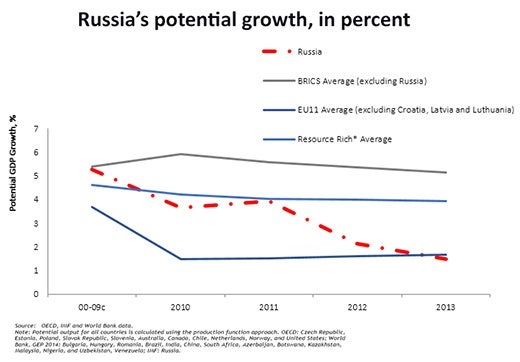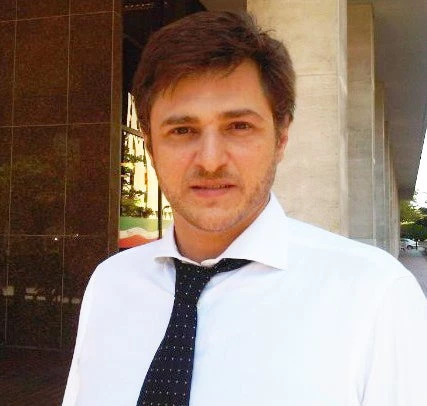Whereas everybody agrees that Russia would benefit from a more diversified economic structure to sustain higher growth rates and living standards, the question is how to achieve it.
In the previous decade the government opted for interventionist policies aiming to develop an industrial base and jumpstart a knowledge economy. More recently, as a reaction to declining oil prices and economic sanctions, the Anti-Crisis Plan launched by the Government in January 2015 fleshes out an active import substitution strategy to replace imports with domestic production. So far, 19 roadmaps have been adopted to promote import substitution in a number of priority sectors, including metallurgy, agriculture, machine-building, chemicals, light industry, as well as the medical and pharmaceutical industries.

The benefits of import substitution are not likely to last. Import-substitution policies may well boost domestic production in the short term, aided by a weak rouble. But they do so at the expense of consumers, who end up paying more and erode overall economic performance by distorting the allocation of resources.
Isolation from global markets may induce companies to choose less modern technology and operate at suboptimal scale, thus reducing productivity. Even in 2012, around half of Russia’s firms considered local markets their main sales destination - a large proportion, even relative to economies of comparable size and structure such as Brazil (where the number is about 35 percent).
In Russia, two factors could potentially explain market fragmentation and less competitive markets: high transport costs (related to limited transport infrastructure and long distances), and additional barriers created by the interventions of regional governments that hamper the entry of firms from outside the region.
Heavy-handed import substitution may further aggravate a situation in which many spheres of corporate activity are dominated by less productive incumbents. These firms are likely to have privileged access to natural resources, markets, credit, and licenses. More efficient enterprises, especially small and medium firms and start-ups, cannot compete with public sector entities and incumbent firms on an equal footing, with the result that the best firms do not emerge or do not survive, inefficient firms remain dominant and overall productivity suffers.
Russia is well endowed with natural resources and human capital, it has begun to rebuild its physical capital, and is weakest in the institutions for the regulation of private enterprise. The first key to future growth lies in improvements in the quality of physical and human capital. It will be equally important to remove structural constraints to total factor productivity, the efficiency with which factors of production are employed.
More responsible use of natural resources, more transparent rules for investors, better planning and monitoring of public investment, and a stronger competition framework would appear to be the priorities for the next decade.
To achieve this, three government functions are essential: (i) the package of fiscal, monetary and exchange rate policies that allow managing macroeconomic volatility; (ii) the capacity of the public administration to effectively deliver public services, such as health, education and infrastructure; (iii) and the ability to effectively regulate private enterprise guaranteeing a competitive environment.
The government’s role in regulating private enterprise is particularly important. Apart from imposing additional costs, regulation can be manipulated with the objective of creating unfair competitive advantages for some firms (not necessarily the most productive) with welfare losses for the rest of the economy.
As argued in Diversified Development, it is time to focus on actions that can increase the economy’s growth potential by diversifying and strengthening the economy’s asset base, its portfolio of natural assets, physical capital, human capital, and institutions.
Related reading:
Russia Economic Report 32: Policy Uncertainty Clouds Medium-Term Prospects
Diversified Development: Making the Most of Natural Resources in Eurasia
In the previous decade the government opted for interventionist policies aiming to develop an industrial base and jumpstart a knowledge economy. More recently, as a reaction to declining oil prices and economic sanctions, the Anti-Crisis Plan launched by the Government in January 2015 fleshes out an active import substitution strategy to replace imports with domestic production. So far, 19 roadmaps have been adopted to promote import substitution in a number of priority sectors, including metallurgy, agriculture, machine-building, chemicals, light industry, as well as the medical and pharmaceutical industries.

The benefits of import substitution are not likely to last. Import-substitution policies may well boost domestic production in the short term, aided by a weak rouble. But they do so at the expense of consumers, who end up paying more and erode overall economic performance by distorting the allocation of resources.
Isolation from global markets may induce companies to choose less modern technology and operate at suboptimal scale, thus reducing productivity. Even in 2012, around half of Russia’s firms considered local markets their main sales destination - a large proportion, even relative to economies of comparable size and structure such as Brazil (where the number is about 35 percent).
In Russia, two factors could potentially explain market fragmentation and less competitive markets: high transport costs (related to limited transport infrastructure and long distances), and additional barriers created by the interventions of regional governments that hamper the entry of firms from outside the region.
Heavy-handed import substitution may further aggravate a situation in which many spheres of corporate activity are dominated by less productive incumbents. These firms are likely to have privileged access to natural resources, markets, credit, and licenses. More efficient enterprises, especially small and medium firms and start-ups, cannot compete with public sector entities and incumbent firms on an equal footing, with the result that the best firms do not emerge or do not survive, inefficient firms remain dominant and overall productivity suffers.
Russia is well endowed with natural resources and human capital, it has begun to rebuild its physical capital, and is weakest in the institutions for the regulation of private enterprise. The first key to future growth lies in improvements in the quality of physical and human capital. It will be equally important to remove structural constraints to total factor productivity, the efficiency with which factors of production are employed.
More responsible use of natural resources, more transparent rules for investors, better planning and monitoring of public investment, and a stronger competition framework would appear to be the priorities for the next decade.
To achieve this, three government functions are essential: (i) the package of fiscal, monetary and exchange rate policies that allow managing macroeconomic volatility; (ii) the capacity of the public administration to effectively deliver public services, such as health, education and infrastructure; (iii) and the ability to effectively regulate private enterprise guaranteeing a competitive environment.
The government’s role in regulating private enterprise is particularly important. Apart from imposing additional costs, regulation can be manipulated with the objective of creating unfair competitive advantages for some firms (not necessarily the most productive) with welfare losses for the rest of the economy.
As argued in Diversified Development, it is time to focus on actions that can increase the economy’s growth potential by diversifying and strengthening the economy’s asset base, its portfolio of natural assets, physical capital, human capital, and institutions.
Related reading:
Russia Economic Report 32: Policy Uncertainty Clouds Medium-Term Prospects
Diversified Development: Making the Most of Natural Resources in Eurasia


Join the Conversation